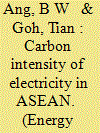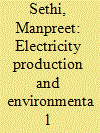|
|
|
Sort Order |
|
|
|
Items / Page
|
|
|
|
|
|
|
| Srl | Item |
| 1 |
ID:
149885


|
|
|
|
|
| Summary/Abstract |
The Association of Southeast Asian Nations (ASEAN), with its ten member countries, has a total population exceeding 600 million. Its energy-related CO2 emissions have been growing and in 2013 amounted to 3.6% of total global emissions. About 40% of ASEAN's energy-related CO2 emissions are currently attributable to electricity production. In view of this high share, we study the CO2 emissions of ASEAN's electricity production sector with a focus on the aggregate emission intensity (ACI) given by the level of CO2 emissions for each unit of electricity produced. Drivers of ACI are analysed for individual countries and spatial analysis is conducted by comparing factors contributing to differences between the ACIs of individual countries and that of the ASEAN average. Arising from these analyses and in light of the current developments, it is concluded that drastic actions need to be taken both at the national and regional levels in order to reduce growth in the region's electricity-related CO2 emissions. Two key policy issues, namely overcoming national circumstances to improve electricity generation mix and improving power generation efficiency, are further discussed.
|
|
|
|
|
|
|
|
|
|
|
|
|
|
|
|
| 2 |
ID:
162958


|
|
|
|
|
| Summary/Abstract |
We analyze to what extent electricity production by non-fossil fuel replaces fossil fueled electricity production in 27 OECD-countries 1980–2014. Depending on model specification, the long run replacement coefficient is in the range of minus 0.4–1.0, which is considerably larger than found in other studies. This means that an increase in non-fossil fuel based electricity production by 10 kWh/capita replaces fossil fuel based production in the range 4–10 kWh/capita. Over all the estimated replacement is not sufficient to prevent economic growth from increasing fossil based electricity production, thus eating up environmental improvements. However, we identify two important exceptions to this. First, countries with a ‘low’ level of fossil based production have an Environmental Kuznets Curve (EKC) relationship when we allow for separate effects of the economic downturn after the Great Recession 2008–2009. Second, results for the EU countries indicate that the EU Emission Trading System, and possibly EU country specific policy instruments, have influenced the mix of electricity production in the intended direction.
|
|
|
|
|
|
|
|
|
|
|
|
|
|
|
|
| 3 |
ID:
158756


|
|
|
| 4 |
ID:
091701


|
|
|
|
|
| Publication |
2009.
|
| Summary/Abstract |
This paper aims at developing an integrated approach for estimating the employment benefits associated with power-generation technologies. The proposed approach exploits the input-output methodology for estimating the direct, indirect and induced employment effects associated with the energy project in question, as well as two different valuation techniques, namely the "opportunity cost of labour" approach and the "public expenditures" approach, for expressing these effects in monetary terms. This framework has been implemented to estimate the employment benefits resulting from the development of a lignite-fired and a natural gas-fired power plant in Greece, taking into account all the stages of the corresponding fuel cycles that are undertaken domestically. The results of the analysis clearly show that lignite-fired electricity generation results in significant employment benefits amounting to 2.9-3.5 €/MWh in the basic scenario. On the other hand, the employment benefits associated with the examined natural gas unit were estimated at 0.4-0.6 €/MWh in the basic scenario. It is also worth mentioning that the significant environmental externalities of the lignite-fired electricity in Greece that have been presented in a number of studies can only be partially compensated by the estimated employment benefits.
|
|
|
|
|
|
|
|
|
|
|
|
|
|
|
|
| 5 |
ID:
176824


|
|
|
|
|
| Summary/Abstract |
Understanding the Granger causality directions between electricity production (EP) and Gross Domestic Product (GDP) is helpful for policymakers in order to design, redesign, and implement effective energy policies. Although there are plenty of studies on this issue, no consistent conclusion about said relationship exists. In this paper, we provide an updated analysis for the case of Mexico in the context of the design and implementation of a new energy policy. We employ three tests, 2 linear and one nonlinear, and find no evidence of causal relation, in a Granger sense, between EP and GDP for the 1965–2018 period. Our results suggest that Mexican policymakers should consider enriching the bill by further designing policies that directly seek to promote a self-sufficient electricity sector by enhancing generation output by private actors and transmission capacity.
|
|
|
|
|
|
|
|
|
|
|
|
|
|
|
|
| 6 |
ID:
104911


|
|
|
|
|
| Publication |
2011.
|
| Summary/Abstract |
We present five performance indicators for electricity generation for 129 countries using the 2005 data. These indicators, measured at the national level, are the aggregate CO2 intensity of electricity production, the efficiencies of coal, oil and gas generation and the share of electricity produced from non-fossil fuels. We conduct a study on the potential for reducing global energy-related CO2 emissions from electricity production through simple benchmarking. This is performed based on the last four performance indicators and the construction of a cumulative curve for each of these indicators. It is found that global CO2 emissions from electricity production would be reduced by 19% if all these indicators are benchmarked at the 50th percentile. Not surprisingly, the emission reduction potential measured in absolute terms is the highest for large countries such as China, India, Russia and the United States. When the potential is expressed as a percentage of a country's own emissions, few of these countries appear in the top-five list.
|
|
|
|
|
|
|
|
|
|
|
|
|
|
|
|
| 7 |
ID:
052300


|
|
|
|
|
| Publication |
Oct 2004.
|
| Summary/Abstract |
This article provides an econometric meta-analysis of the disparity of results among a large sample of electricity externality studies. Most importantly, the analysis shows that parts of the disparity can be attributed to methodological differences; the abatement cost and top-down damage cost approaches tend to produce higher external cost estimates, ceteris paribus, than does the bottom-up damage cost approach. There are also systematical differences in magnitudes among fuels; as expected some of the fuels (i.e., coal and oil) have more adverse impacts than do the renewables (i.e., hydro, wind and solar). Furthermore, the studies that have addressed the full fuel cycle tend to produce higher externality estimates. However, the analysis carried out here is not sufficient to explain all of the variability in externality estimates. Thus, overall the results suggest that the possibility of making general policy decisions based on the studies carried out so far may be limited, implying that existing externality studies may have to be improved in order to become more useful for policy makers.
|
|
|
|
|
|
|
|
|
|
|
|
|
|
|
|
| 8 |
ID:
128037


|
|
|
|
|
| Summary/Abstract |
Onshore wind energy is a key component of the renewable energies used by governments to reduce carbon emissions from electricity production, but will carbon emissions be reduced when wind farms are located on carbon-rich peatands? Wind farms are often located in uplands because most are of low agricultural value, are distant from residential areas, and are windy. Many UK uplands are peatlands, with layers of accumulated peat that represent a large stock of soil carbon. When peatlands are drained for construction there is a higher risk of net carbon loss than for mineral soils. Previous work suggests that wind farms sited on peatlands can reduce net carbon emissions if strictly managed for maximum retention of carbon. Here we show that, whereas in 2010, most sites had potential to provide net carbon savings, by 2040 most sites will not reduce carbon emissions even with careful management. This is due to projected changes in the proportion of fossil fuels used to generate electricity. The results suggest future policy should avoid constructing wind farms on undegraded peatlands unless drainage of peat is minimal and the volume excavated in foundations can be significantly reduced compared to energy output.
|
|
|
|
|
|
|
|
|
|
|
|
|
|
|
|
|
|
|
|
|